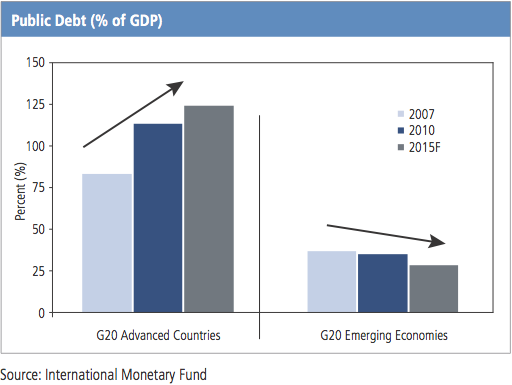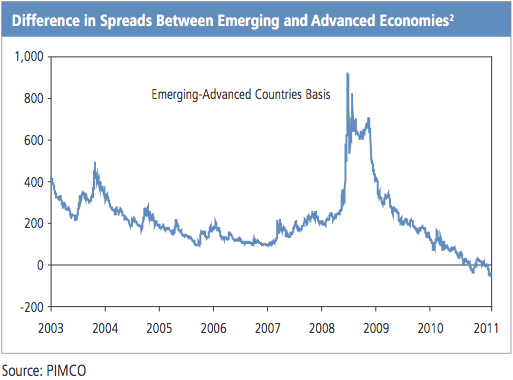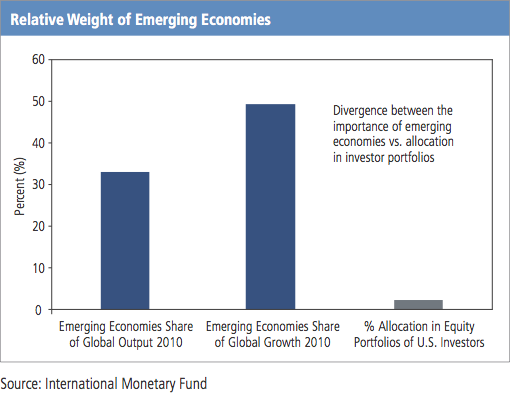Perhaps an underappreciated consequence of the 2008 global financial crisis has been a great divergence in the fortunes of developed economies and those of emerging markets. In its May “Secular Outlook“, the bond fund manager PIMCO has some very nice charts that illustrate this process well.
First, while the debt levels of G20 advanced economies continue to soar, emerging market economies are actually reducing debt levels as their growth continues to outpace the developed world. This is a huge break from historical experience. After all, the biggest debt crises of the past several decades have occurred in emerging market regions such as Latin America. No more.

As a consequence, emerging-market economies are for the first time in history paying less to issue debt than their developed country counterparts. [Note: Felix Salmon says that PIMCO has mislabelled this chart and it is actually showing emerging markets versus Western Europe, rather than all advanced economies. Regardless, the point stands. The great divergence in the growth fortunes and debt levels of developed and developing economies has led to a great convergence in perceptions of market risk between the two. ]

Now, this huge shift in the composition of global growth has some important implications for the asset allocation of investors. If emerging markets have become less risky than they were in the past, doesn’t this imply that we should think about raising our exposure to them as investors? Indeed it does. But despite the fact that emerging-market economies account for around half of global growth today, their share in the portfolio of the average US investor is still a meager 1-2%. When you consider the fairly poor return prospects of US (and most other developed countries) equities over the coming decade or more, this trend probably needs to change.

However, such a change will not come easily, as it will require a fundamental rethink of many of the basic assumptions and practices that lie at the heart of modern investing. As PIMCO argues:
…the next few years will require investors to upgrade and retool a whole set of conceptual and operational approaches that have served us well in the past but are less relevant going forward and, in some cases, could even be dangerous…
Ongoing changes in the global economy are still inadequately captured in the construction of traditional indices, asset allocation methodologies and investment guidelines. As an illustration, conceptual constructs, including market cap approaches, will likely prove less useful; and a sustained effort will be needed to counter well- entrenched home biases that result in asset allocations that are increasingly inconsistent with domestic and global re-alignments.
This probably requires a bit of explanation. “Home bias” refers to the tendency of investors all over the world to allocate a large proportion of their investments to the local market. As a result they subject themselves to greater risk and miss out on the diversification potential of investing in foreign assets. Think of a typical Australian investor with an owner-occupied home, a couple of investment properties, and a super fund that is heavily exposed to the local stockmarket (which itself is heavily concentrated in resources and financials). All of these assets are highly correlated. In the case of a sharp slowdown in China, for example, they are all likely to crash at the same time.
In fact, a study by Towers Watson in 2010 shows that Australian super funds have 64% of their total equity exposure invested in the local market – despite Australia representing only about 4% of the MSCI World Index. And the reason why? Putting aside certain tax advantages of investing locally, the argument is that Australian equities have outperformed global equities over most ten-year periods in the last three decades.
But as we all should know, past performance is no guarantee of future results.
In any case, what is PIMCO talking about in relation to rethinking the construction of traditional indices?
Let me give an example. Let’s say you want to put some money in a global bond fund. Most of these funds are managed against an index that contains the debt of countries around the world, weighted according to market capitalisation. But there is a major problem with such an approach. The countries with the highest weight in such an index will be the countries that are issuing the most debt, and — quite possibly, the countries that have the highest probability of defaulting. In contrast, countries that are “fiscally responsible” will have a lower weight in the index. This doesn’t make a whole lot of sense.
As PIMCO says, we are going to have to fundamentally rethink some of our approaches to investing that may have worked well in the past, but have become outdated. A greater emphasis on fast growing emerging markets with favourable demographics will undoubtedly be part of this.
But that’s enough for today. More in future posts.